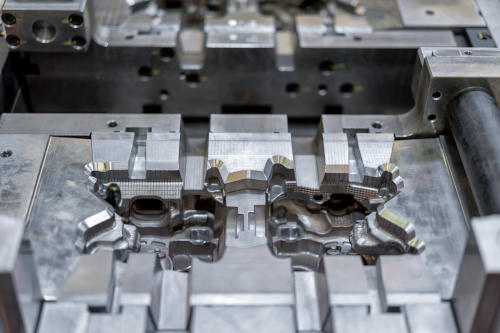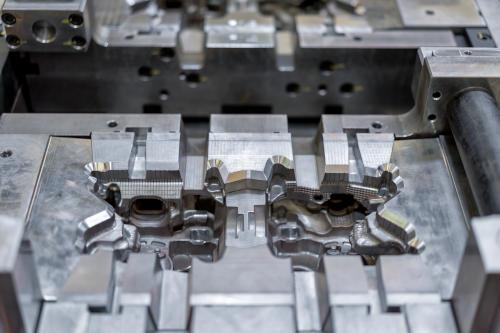The three types of slag inclusions that are most frequently found in the gate of die-casting parts made of aluminum alloy are shrinkage cavities, oil stains, and chilled hard layers. These are the three types of slag inclusions. These are the three types of slag inclusions that are most frequently encountered. In the event that oily slag inclusions are present on the punch, we have the ability to make modifications to the quantity of punch lubricating oil, the filling position, and the method of supply. When it comes to incorporating cold hard layer slag into the material, the primary method that we use is to adjust the injection delay into the material. These concerns include, but are not limited to, the shrinkage cavities, oil stains, and chilled hard layers. It is essential to take into consideration the fact that oil-contaminated slag inclusions constitute more than sixty percent of the total slag inclusions, chilled hard layers constitute approximately thirty-five percent of the total slag inclusions, and shrinkage cavities constitute five percent of the total slag inclusions of the slag. The interiors of these holes are relatively clean, despite the fact that the surface of these holes is rough. It is difficult to determine the shape of these holes.
After the liquid aluminum has been poured into the mold cavity, the punch oil is not completely burned by the process. After that, it is encased in the liquid aluminum in order to generate impurities and to fill the cavity of the mold together. Once the mold cavity has been completely filled, this process is repeated die casting cable clamps until it is finished. There is a significant amount of flow resistance in the inner gate, despite the fact that the cross-sectional area of the gate is relatively small. Despite the fact that the gate has a relatively small area, this appears to be the case.
At the gate of a die-casting part made of aluminum alloy, there are holes that are comparable to shrinkage cavities. These holes are created when the sprue cake of the component is removed from the component. The interiors of these holes are relatively clean, despite the fact that the surface of these holes is rough. It is difficult to determine the shape of these holes. The aluminum liquid is inserted into the cavity of the mold when the filling process is carried out at a high rate of speed. It is after the liquid has been added that this takes place. During the stage of the punch that operates at a low speed, the chilled hard layer gradually gathers at the end of the Al liquid. This occurs during the stage. This takes place while the stage is being performed. As a result of the presence of a significant number of gaps nodular cast iron between the base material that surrounds the aluminum alloy die casting and the die casting itself, not only does the appearance of the die casting change, but it also has a negative impact on the strength of the die casting. The second discovery that was made during the inspection was that the flow rate of the point cooling water at the gate attachment was either significantly low or completely blocked.

This was the second discovery that was made. as a result of the scaling that occurs in the copper pipe as a result of the fact that it is being utilized, the problem has arisen. It is possible to observe a decrease in the cross-sectional area of the anterior region.
One can choose between two different paths, which are as follows:
The inspection of cooling water ought to be included on the list of mold preservation inspection items, and particular instructions ought to be provided concerning the method of detecting the flow of cooling water as well as the duration of the inspection.
For the purpose of ensuring that the length of the copper tube that is utilized for the purpose of cooling water is in accordance with the requirements that are specified in the drawing, it is necessary to check the same. The rectification took place, which resulted in a significant decrease in the temperature of the mold that was measured. This indicated that both shrinkage cavities and slag inclusions were almost completely eliminated nodular cast iron after the process. After the release agent has been applied, the punch is brought back to the barrel in order to clean it. This is done after the release agent has been applied. The lubricating oil for the punch is then dripped into the barrel after that step has been completed. A discussion of the incorporation of hard layer slag as well as the possible solutions to the issue
Immediately following the injection of the aluminum liquid into the barrel, a layer of liquid that has been chilled will be formed on the surface of the barrel that comes into contact with the liquid. This will take place right after the injection has been administered. Therefore, a method that is effective in reducing the chilled hard layer is to shorten the injection delay, which means to shorten the contact time between the aluminum liquid and the low-temperature barrel. This is a method that can be used to reduce the quantity of the chilled hard layer. The amount of time that the aluminum liquid is physically in contact with the barrel is reduced as a result of this. We would appreciate another five seconds. It is impossible to avoid making mistakes in the particulars if you use completely unified process parameters. This is an unavoidable and inevitable consequence. Specifically, this is because the slow movement of the worker is the cause of the slow movement of the spoon. This is the reason die casting cable clamps why this is the case. This is done in order to ensure that the task is carried out on-site in a manner that is both effective and satisfactory in accordance with the requirements.
If you use a traditional spoon to scoop soup, you will invariably end up with some oxide layer on the surface of the soup. This is because oxides are easily oxidized. It is recommended that a secondary degassing treatment be carried out on the aluminum liquid after it has been allowed to stand for a period of time that is longer than two hours. Following the completion of the treatment for slag removal, this operation ought to be carried out. Because of this, the cold hard layer that is present in the aluminum liquid is reduced, which also contributes to an improvement in the purity of the aluminum liquid. All of these factors work together to make the aluminum liquid more pure.

